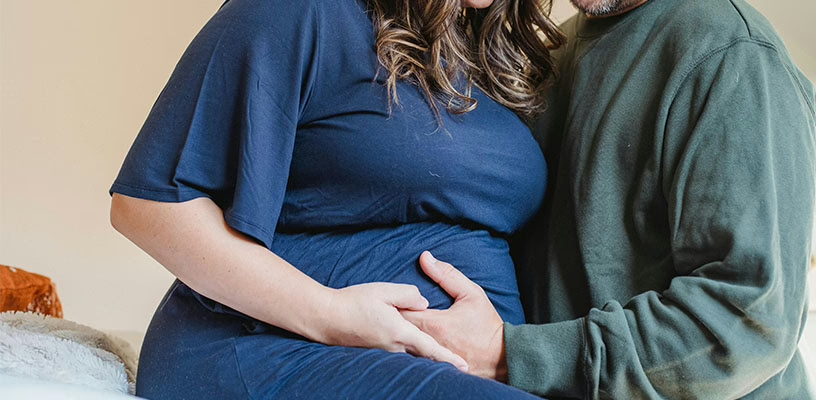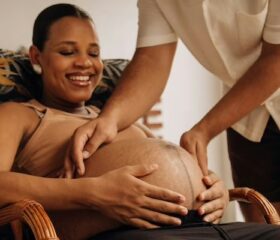When Can You Feel Your Baby Move and Kick?
Whether you just felt your baby’s first kicks or you’re still patiently waiting for them, it’s a good idea to read up on what constitutes “normal” moving and kicking for your little one.

You may have a million burning questions about your baby’s movements, especially if this is your first pregnancy—is she moving enough? Are her movements too strong? Too weak?
Read on to learn when and how often you’ll feel your baby move and kick, how they feel, and how to check if she’s doing well from her acrobatics.
When will you start feeling your baby’s movements?
You may first feel your baby move around weeks 16–21 (your second trimester), right around the time when your pregnancy starts showing. These first perceptible flutters from your baby are known as “quickening.”
She may have been moving in your belly since as early as week 15. 1 However, it’s hard to feel your baby’s movements that early on, as she’s still so small, and her movements are very subtle.
Keep in mind that exactly when you’ll feel your baby move varies from pregnancy to pregnancy. Here are some factors that affect how soon you may feel your baby’s movements:
- If you’ve been pregnant before: If this is your first pregnancy, it may take you a bit longer to recognize the subtle sensations of fetal movement than it usually does for experienced moms. 2
- Your body type: Women with higher body mass indices (BMIs) might feel their baby’s movements later than those with lower BMIs. 3
- Your placenta position: Some women have anterior placentas (i.e., the placenta is in the front of the uterus). 4 This typically won’t lead to any complications, but the placenta may muffle your baby’s movements and make them harder to feel.
What will your baby’s movements feel like?
By and large, your baby’s movements will be very subtle in the early stages. You may even mistake them for gas or hunger pangs. Many women report that their babies’ movements feel like: 5
- Butterflies: A light fluttering or tickling sensation, as if you have butterflies in your stomach.
- Bubbles: A gentle bubbling or popping, like gas moving around.
- A fish swimming: A soft swishing or “rolling” feeling, almost like a tiny fish swimming in your belly. 6
As she grows, she’ll get stronger, and her movements will become more consistent and distinct. You might feel: 7
- Jabs and kicks: You may even be able to feel these stronger punches, kicks, or jabs from the outside of your belly—meaning your family and friends can also join in on the fun!
- Rolls and stretches: You’ll feel smoother, whole-body movements as your baby shifts position.
- Hiccups: If you feel rhythmic, repetitive jerking movements like gentle taps, they may actually be your baby’s hiccups, not her kicks.
Note that your baby may be able to respond to sounds as early as 22 weeks and 24 weeks of pregnancy. 8 It’s a good idea to start talking to her when she’s still in your womb to familiarize her with your voice and bond with her. You might even feel her kick out in response.
How often should you feel your baby’s movements?
As mentioned, you’ll probably start feeling your baby’s movements during your second trimester. Her movements may still be sporadic; you might feel several kicks one day and then none the next, which is perfectly normal.
However, as you enter your third trimester, you should feel your baby move consistently every day. 9 While there isn’t a set number of movements you should expect, you may notice regular patterns, such as periods of activity followed by periods of rest.
Common myths about fetal movements
You may have heard many theories about what your baby’s movements should be like. Chances are that at least some of them aren’t true.
Here are a few common myths and misconceptions you should be aware of:
- All babies move the same: As we’ve noted, every baby is different, and their movement patterns will vary. Don’t compare your baby’s activity level to that of other babies. The most important thing is to learn what’s normal for yours and let your doctor know if she deviates from that pattern.
- More movement means a hyper child: If your baby is particularly active in your womb, it doesn’t necessarily mean she’ll be a hyper child later on. It just means she’s a healthy baby and she’s working to strengthen her muscles and bones.
- Babies move less near their due dates: With less space to stretch out, your baby’s movement type may change (e.g., with more gentle pushing instead of sharp kicking) as your due date approaches. However, the frequency of her movements shouldn’t decrease, and you should feel your baby move up until you go into labor and even during labor itself. 1011
It’s very important to continue doing fetal kick counts
You should start doing kick counts at the 28-week mark. It’s important to keep doing those, even when your baby’s movements become less evident due to her limited space. If your baby starts moving less frequently, tell your doctor right away. We’ll review exactly how to perform kick counts a little further down in this article.
Factors that may affect your baby’s movement
There are a number of factors that may influence your baby’s activity levels, including: 11
- Time of day: Babies are often more active during the evenings. You may notice your baby’s movement increase throughout the day and peak at night.
- Mealtimes: Your baby may become more active approximately an hour after you eat due to the spike in glucose (sugar) in your blood.
- Your baby’s sleep cycle: Like grownups, babies have sleep-wake cycles. It’s normal to have periods of less movement when your baby sleeps. Unfortunately, these might not coincide with your own sleep schedule.
You might also feel like your baby moves less when you’re active. That’s usually just because it’s harder to notice her movements than when you’re resting.
How do you count your baby’s kicks?
At the beginning of your third trimester (around week 28), your healthcare provider might suggest that you start doing “fetal movement counting” or “kick counting.” 12 This is an easy way to check if your baby’s active and healthy.
Here’s how to do it:
- Choose a time of day when your baby is typically active.
- Sit quietly or lie on your side.
- Holding that position, time how long it takes to feel 10 distinct movements. These can be kicks, rolls, or jabs. Don’t count hiccups. 13
- You should be able to feel at least 10 movements within two hours. 12
- Do this at roughly the same time each day, and note how long it takes your baby to get to 10 movements. Soon, you’ll know what your baby’s typical patterns are.
When should you be concerned about your baby’s movements?
Knowing what red flags to look out for in your baby’s movements is just as important as learning her normal activity patterns. Be aware of the following changes: 2 14
- Fewer movements
- Weaker movements
- A sudden increase in movement
What should you do if you notice changes?
If you notice any significant changes in your baby’s movement patterns or just feel like something’s not right, trust your instincts and contact your doctor immediately.
If your doctor doesn’t answer your call, head straight to the hospital. Don’t wait until your next scheduled appointment or the next day to seek help. A change in your baby’s movement can mean she’s in distress, and it might be the only warning sign that something’s wrong.
Your doctor will be able to give your baby the necessary care right away. Even if it turns out to be nothing serious, it’s better to be on the safe side.
What not to do if you notice changes
Don’t try to self-diagnose or use tricks you saw online to get your baby to move, such as drinking cold water or having a sugary treat. These methods aren’t reliable.
You should also avoid using home monitoring devices such as handheld monitors, home Dopplers, or phone apps to check your baby’s heartbeat. These devices can be misleading and don’t provide the same level of accuracy as actual medical equipment. 15
Final thoughts
Feeling your baby move and kick is one of the most exciting sensations a mom can experience. These are her earliest interactions with you—her whole world at the moment—so keep strengthening your bond by talking or singing to her.
Keep up the good work; your baby is lucky to have you as her mom!
Article Sources
- MedlinePlus. "Fetal development" Retrieved April 16, 2025.
- Tommy’s. "Baby movements in pregnancy" Retrieved April 16, 2025.
- The University of Texas Southwestern Medical Center. "Feeling your baby move during pregnancy" Retrieved April 16, 2025.
- MedlinePlus. "Percutaneous umbilical cord blood sampling - series—Procedure, part 2" Retrieved April 16, 2025.
- PeaceHealth. "Your Baby's Movements During Pregnancy" Retrieved April 16, 2025.
- Cleveland Clinic. "Quickening in Pregnancy" Retrieved April 16, 2025.
- Kaiser Permanente . "Your Baby's Movements During Pregnancy" Retrieved April 16, 2025.
- U.S. Centers for Disease Control and Prevention. "About Noise and Reproductive Health" Retrieved April 16, 2025.
- UCSF Obstetrics Services. "PregnancyGuidebook_8_2023" Retrieved April 16, 2025.
- Florida Department of Health. "Count the Kicks" Retrieved April 16, 2025.
- University of Rochester Medical Center. "Fetal Movement Counting" Retrieved April 16, 2025.
- Maternal Infant Health Program Utah. "Your Baby’s Activity Record - A guide to counting your baby’s movements" Retrieved April 16, 2025.
- Florida Department of Health. "Paper-Kick-Chart-English" Retrieved April 16, 2025.
- PUSH Pregnancy. "Movements Matter" Retrieved April 16, 2025.
- Tommy’s. "Movements Matter: A warning against home heartbeat Dopplers for monitoring babies' health" Retrieved April 16, 2025.







